| Revision as of 07:20, 30 January 2010 view sourceVentusa (talk | contribs)Extended confirmed users1,027 editsm →List← Previous edit | Revision as of 11:12, 18 February 2010 view source Qworty (talk | contribs)13,129 editsmNo edit summaryNext edit → | ||
| Line 24: | Line 24: | ||
| There have been 47 ] from ] to ]. Originally, the Vice President was the person who received the second most votes for ] in the ]. However, in the ] a tie in the electoral college between ] and ] led to the selection of the President by the ]. To prevent such an event from happening again, the ] was added to the Constitution, creating the current system where electors cast a separate ballot for the Vice Presidency.<ref name="Senate">{{cite web | title = Vice President of the United States (President of the Senate) | publisher = United States Senate | url = http://www.senate.gov/artandhistory/history/common/briefing/Vice_President.htm | accessdate = 2009-06-10}}</ref> | There have been 47 ] from ] to ]. Originally, the Vice President was the person who received the second most votes for ] in the ]. However, in the ] a tie in the electoral college between ] and ] led to the selection of the President by the ]. To prevent such an event from happening again, the ] was added to the Constitution, creating the current system where electors cast a separate ballot for the Vice Presidency.<ref name="Senate">{{cite web | title = Vice President of the United States (President of the Senate) | publisher = United States Senate | url = http://www.senate.gov/artandhistory/history/common/briefing/Vice_President.htm | accessdate = 2009-06-10}}</ref> | ||
| The Vice President has few powers explicitly provided for in the constitution. |
The Vice President has few powers explicitly provided for in the constitution. His primary function is to succeed to the Presidency if that office becomes open due to the death, resignation or removal from office (via the impeachment process) of a sitting President. Nine Vice Presidents have ascended to the Presidency in this way. In addition, the Vice President serves as the President of the ] and may choose to cast a tie-breaking vote on decisions made by the Senate. Vice Presidents have exercised this latter power to varying extents over the years.<ref name=Senate/> The Vice Presidency was described by former VP ] in 1960 as "not worth a bucket of warm ].<ref>{{cite news |first=Sidney |last=Blumenthal |title=The imperial vice presidency| url=http://www.salon.com/opinion/blumenthal/2007/06/28/cheney/| publisher=Salon.com| date=2007-06-28| accessdate=2007-09-22}}</ref> | ||
| Prior to passage of the ], a vacancy in the office of the Vice President could not be replaced until the next election. Such vacancies were common; sixteen occurred before the 25th Amendment was passed as a result of seven deaths, one resignation, and eight cases where the Vice President succeeded to the Presidency. This amendment allowed for a vacancy to be filled with appointment by the President and confirmation by both houses of Congress. Since its passage two Vice Presidents have been appointed through that process, ] in 1973 and ] in 1974.<ref name=Senate/> | Prior to passage of the ], a vacancy in the office of the Vice President could not be replaced until the next election. Such vacancies were common; sixteen occurred before the 25th Amendment was passed as a result of seven deaths, one resignation, and eight cases where the Vice President succeeded to the Presidency. This amendment allowed for a vacancy to be filled with appointment by the President and confirmation by both houses of Congress. Since its passage two Vice Presidents have been appointed through that process, ] in 1973 and ] in 1974.<ref name=Senate/> | ||
Revision as of 11:12, 18 February 2010
| Party | Vice Presidents |
|---|---|
| Republican | 20 |
| Democratic | 18 |
| Democratic-Republican | 6 |
| Whig | 2 |
| Federalist | 1 |
| Vacancies | 18 |
There have been 47 Vice Presidents of the United States from John Adams to Joe Biden. Originally, the Vice President was the person who received the second most votes for President in the Electoral College. However, in the election of 1800 a tie in the electoral college between Thomas Jefferson and Aaron Burr led to the selection of the President by the House of Representatives. To prevent such an event from happening again, the Twelfth Amendment was added to the Constitution, creating the current system where electors cast a separate ballot for the Vice Presidency.
The Vice President has few powers explicitly provided for in the constitution. His primary function is to succeed to the Presidency if that office becomes open due to the death, resignation or removal from office (via the impeachment process) of a sitting President. Nine Vice Presidents have ascended to the Presidency in this way. In addition, the Vice President serves as the President of the Senate and may choose to cast a tie-breaking vote on decisions made by the Senate. Vice Presidents have exercised this latter power to varying extents over the years. The Vice Presidency was described by former VP John Nance Garner in 1960 as "not worth a bucket of warm piss.
Prior to passage of the Twenty-fifth Amendment, a vacancy in the office of the Vice President could not be replaced until the next election. Such vacancies were common; sixteen occurred before the 25th Amendment was passed as a result of seven deaths, one resignation, and eight cases where the Vice President succeeded to the Presidency. This amendment allowed for a vacancy to be filled with appointment by the President and confirmation by both houses of Congress. Since its passage two Vice Presidents have been appointed through that process, Gerald Ford in 1973 and Nelson Rockefeller in 1974.
Vice Presidents have hailed from 21 states. More than half have come from only five states, New York (11), Indiana (5), Massachusetts (4), Kentucky (3), and Texas (3). Most Vice Presidents have been in their 50s or 60s and had political experience prior to assuming the office.
List
- Parties
Federalist Democratic-Republican Democratic Whig Republican
| # | Image | Name |
Home state |
Took office |
Left office |
Party |
President(s) |
Ref |
|---|---|---|---|---|---|---|---|---|
| 1 |  |
John Adams | Massachusetts | April 21, 1789 | March 4, 1797 | Federalist | Washington | |
| 2 | Thomas Jefferson | Thomas Jefferson | Virginia | March 4, 1797 | March 4, 1801 | Democratic-Republican | J. Adams | |
| 3 |  |
Aaron Burr | New York | March 4, 1801 | March 4, 1805 | Democratic-Republican | Jefferson | |
| 4 | 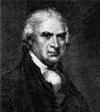 |
George Clinton | New York | March 4, 1805 | April 20, 1812 | Democratic-Republican | Jefferson/ Madison |
|
| zVacant | April 20, 1812 | March 4, 1813 | Madison | |||||
| 5 | 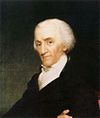 |
Elbridge Gerry | Massachusetts | March 4, 1813 | November 23, 1814 | Democratic-Republican | Madison | |
| zVacant | November 23, 1814 | March 4, 1817 | Madison | |||||
| 6 |  |
Daniel D. Tompkins | New York | March 4, 1817 | March 4, 1825 | Democratic-Republican | Monroe | |
| 7 |  |
John C. Calhoun | South Carolina | March 4, 1825 | December 28, 1832 | Democratic-Republican/ Democratic |
J. Q. Adams/ Jackson |
|
| zVacant | December 28, 1832 | March 4, 1833 | Jackson | |||||
| 8 |  |
Martin Van Buren | New York | March 4, 1833 | March 4, 1837 | Democratic | Jackson | |
| 9 | Richard Mentor Johnson | Richard Mentor Johnson | Kentucky | March 4, 1837 | March 4, 1841 | Democratic | Van Buren | |
| 10 |  |
John Tyler | Virginia | March 4, 1841 | April 4, 1841 | Whig | W. Harrison | |
| zVacant | April 4, 1841 | March 4, 1845 | Tyler | |||||
| 11 |  |
George M. Dallas | Pennsylvania | March 4, 1845 | March 4, 1849 | Democratic | Polk | |
| 12 | 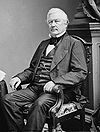 |
Millard Fillmore | New York | March 4, 1849 | July 9, 1850 | Whig | Taylor | |
| zVacant | July 9, 1850 | March 4, 1853 | Fillmore | |||||
| 13 |  |
William R. King | Alabama | March 4, 1853 | April 18, 1853 | Democratic | Pierce | |
| zVacant | April 18, 1853 | March 4, 1857 | Pierce | |||||
| 14 |  |
John C. Breckinridge | Kentucky | March 4, 1857 | March 4, 1861 | Democratic | Buchanan | |
| 15 |  |
Hannibal Hamlin | Maine | March 4, 1861 | March 4, 1865 | Republican | Lincoln | |
| 16 |  |
Andrew Johnson | Tennessee | March 4, 1865 | April 15, 1865 | Democratic | Lincoln | |
| zVacant | April 15, 1865 | March 4, 1869 | A. Johnson | |||||
| 17 |  |
Schuyler Colfax | Indiana | March 4, 1869 | March 4, 1873 | Republican | Grant | |
| 18 |  |
Henry Wilson | Massachusetts | March 4, 1873 | November 22, 1875 | Republican | Grant | |
| zVacant | November 22, 1875 | March 4, 1877 | Grant | |||||
| 19 | 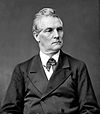 |
William A. Wheeler | New York | March 4, 1877 | March 4, 1881 | Republican | Hayes | |
| 20 |  |
Chester A. Arthur | New York | March 4, 1881 | September 19, 1881 | Republican | Garfield | |
| zVacant | September 19, 1881 | March 4, 1885 | Arthur | |||||
| 21 | 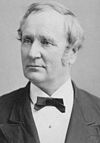 |
Thomas A. Hendricks | Indiana | March 4, 1885 | November 25, 1885 | Democratic | Cleveland | |
| zVacant | November 25, 1885 | March 4, 1889 | Cleveland | |||||
| 22 | 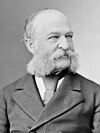 |
Levi P. Morton | New York | March 4, 1889 | March 4, 1893 | Republican | B. Harrison | |
| 23 |  |
Adlai E. Stevenson | Illinois | March 4, 1893 | March 4, 1897 | Democratic | Cleveland | |
| 24 | 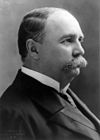 |
Garret Hobart | New Jersey | March 4, 1897 | November 21, 1899 | Republican | McKinley | |
| zVacant | November 21, 1899 | March 4, 1901 | McKinley | |||||
| 25 | 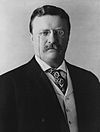 |
Theodore Roosevelt | New York | March 4, 1901 | September 14, 1901 | Republican | McKinley | |
| zVacant | September 14, 1901 | March 4, 1905 | T. Roosevelt | |||||
| 26 |  |
Charles W. Fairbanks | Indiana | March 4, 1905 | March 4, 1909 | Republican | T. Roosevelt | |
| 27 | 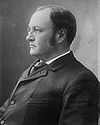 |
James S. Sherman | New York | March 4, 1909 | October 30, 1912 | Republican | Taft | |
| zVacant | October 30, 1912 | March 4, 1913 | Taft | |||||
| 28 | 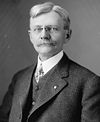 |
Thomas R. Marshall | Indiana | March 4, 1913 | March 4, 1921 | Democratic | Wilson | |
| 29 |  |
Calvin Coolidge | Massachusetts | March 4, 1921 | August 2, 1923 | Republican | Harding | |
| zVacant | August 2, 1923 | March 4, 1925 | Coolidge | |||||
| 30 |  |
Charles G. Dawes | Illinois | March 4, 1925 | March 4, 1929 | Republican | Coolidge | |
| 31 | 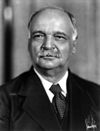 |
Charles Curtis | Kansas | March 4, 1929 | March 4, 1933 | Republican | Hoover | |
| 32 |  |
John Nance Garner | Texas | March 4, 1933 | January 20, 1941 | Democratic | F. Roosevelt | |
| 33 |  |
Henry A. Wallace | Iowa | January 20, 1941 | January 20, 1945 | Democratic | F. Roosevelt | |
| 34 | 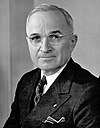 |
Harry Truman | Missouri | January 20, 1945 | April 12, 1945 | Democratic | F. Roosevelt | |
| zVacant | April 12, 1945 | January 20, 1949 | Truman | |||||
| 35 |  |
Alben Barkley | Kentucky | January 20, 1949 | January 20, 1953 | Democratic | Truman | |
| 36 | 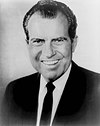 |
Richard Nixon | California | January 20, 1953 | January 20, 1961 | Republican | Eisenhower | |
| 37 |  |
Lyndon Johnson | Texas | January 20, 1961 | November 22, 1963 | Democratic | Kennedy | |
| zVacant | November 22, 1963 | January 20, 1965 | L. Johnson | |||||
| 38 |  |
Hubert Humphrey | Minnesota | January 20, 1965 | January 20, 1969 | Democratic | L. Johnson | |
| 39 |  |
Spiro Agnew | Maryland | January 20, 1969 | October 10, 1973 | Republican | Nixon | |
| zVacant | October 10, 1973 | December 6, 1973 | Nixon | |||||
| 40 | 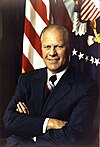 |
Gerald Ford | Michigan | December 6, 1973 | August 9, 1974 | Republican | Nixon | |
| zVacant | August 9, 1974 | December 19, 1974 | Ford | |||||
| 41 |  |
Nelson Rockefeller | New York | December 19, 1974 | January 20, 1977 | Republican | Ford | |
| 42 |  |
Walter Mondale | Minnesota | January 20, 1977 | January 20, 1981 | Democratic | Carter | |
| 43 |  |
George H. W. Bush | Texas | January 20, 1981 | January 20, 1989 | Republican | Reagan | |
| 44 |  |
Dan Quayle | Indiana | January 20, 1989 | January 20, 1993 | Republican | G. H. W. Bush | |
| 45 |  |
Al Gore | Tennessee | January 20, 1993 | January 20, 2001 | Democratic | Clinton | |
| 46 |  |
Dick Cheney | Wyoming | January 20, 2001 | January 20, 2009 | Republican | G. W. Bush | |
| 47 |  |
Joe Biden | Delaware | January 20, 2009 | Incumbent | Democratic | Obama |
Notes
Arriving in New York City before President-elect George Washington, Adams was sworn as Vice President nine days before the President
Died in office
Resigned from office
Succeeded to the Presidency upon death or resignation of President
The only Vice President to be sworn in outside of the United States of America (in Havana, Cuba), with special dispensation from Congress
Elected on the National Union Party ticket with Republican Abraham Lincoln
Office of Vice President filled under provisions of 25th Amendment
Invoked the presidential provision of the 25th Amendment on July 13, 1985, 11:28 a.m. until 7:22 p.m.
A resident of Texas at the time of his nomination for Vice President, Mr. Cheney changed his voter registration back to Wyoming, where he had served in Congress, to avoid violating the 12th Amendment, which would have prevented the Texas Presidential Electors from casting their electoral votes for both Bush and Cheney
Served under the acting-presidential provision of the 25th Amendment on two separate occasions: on June 29, 2002, from 7:09 a.m. to 9:24 a.m, and on July 21, 2007, from 7:16 a.m. to 9:21 a.m.
References
- ^ "Vice President of the United States (President of the Senate)". United States Senate. Retrieved 2009-06-10.
- Blumenthal, Sidney (2007-06-28). "The imperial vice presidency". Salon.com. Retrieved 2007-09-22.
- "John Adams". United States Senate. Retrieved 2009-12-12.
- "Thomas Jefferson". United States Senate. Retrieved 2009-12-12.
- "Aaron Burr". United States Senate. Retrieved 2009-06-10.
- "George Clinton". United States Senate. Retrieved 2009-06-10.
- "Elbridge Gerry". United States Senate. Retrieved 2009-06-10.
- "Daniel Tompkins". United States Senate. Retrieved 2009-06-10.
- "John Calhoun". United States Senate. Retrieved 2009-06-10.
- "Martin Van Buren". United States Senate. Retrieved 2009-06-10.
- "Richard Mentor Johnson". United States Senate. Retrieved 2009-06-10.
- "John Tyler". United States Senate. Retrieved 2009-06-10.
- "George Dallas". United States Senate. Retrieved 2009-06-10.
- "Millard Fillmore". United States Senate. Retrieved 2009-06-10.
- "William Rufus King". United States Senate. Retrieved 2009-06-10.
- "John Breckinridge". United States Senate. Retrieved 2009-06-10.
- "Hannibal Hamlin". United States Senate. Retrieved 2009-06-10.
- "Andrew Johnson". United States Senate. Retrieved 2009-06-10.
- "Schuyler Colfax". United States Senate. Retrieved 2009-06-10.
- "Henry Wilson". United States Senate. Retrieved 2009-06-10.
- "William Wheeler". United States Senate. Retrieved 2009-06-10.
- "Chester Arthur". United States Senate. Retrieved 2009-06-10.
- "Thomas Hendricks". United States Senate. Retrieved 2009-06-10.
- "Levi Morton". United States Senate. Retrieved 2009-06-10.
- "Adlai Stevenson". United States Senate. Retrieved 2009-06-10.
- "Garret Hobart". United States Senate. Retrieved 2009-06-10.
- "Theodore Roosevelt". United States Senate. Retrieved 2009-06-10.
- "Charles Fairbanks". United States Senate. Retrieved 2009-06-10.
- "James Sherman". United States Senate. Retrieved 2009-06-10.
- "Thomas Marshall". United States Senate. Retrieved 2009-06-10.
- "Calvin Coolidge". United States Senate. Retrieved 2009-06-10.
- "Charles Dawes". United States Senate. Retrieved 2009-06-10.
- "Charles Curtis". United States Senate. Retrieved 2009-06-10.
- "John Nance Garner". United States Senate. Retrieved 2009-06-10.
- "Henry Wallace". United States Senate. Retrieved 2009-06-10.
- "Harry Truman". United States Senate.
{{cite news}}: Text "accessdate 2009-06-10" ignored (help) - "Alben Barkley". United States Senate. Retrieved 2009-06-10.
- "Richard Nixon". United States Senate. Retrieved 2009-06-10.
- "Lyndon Johnson". United States Senate. Retrieved 2009-06-10.
- "Hubert Humphrey". United States Senate. Retrieved 2009-06-10.
- "Spiro Agnew". United States Senate. Retrieved 2009-06-10.
- "Gerald Ford". United States Senate. Retrieved 2009-06-10.
- "Nelson Rockefeller". United States Senate. Retrieved 2009-06-10.
- "Walter Mondale". United States Senate. Retrieved 2009-06-10.
- "George Bush". United States Senate. Retrieved 2009-06-10.
- "Dan Quayle". United States Senate. Retrieved 2009-06-10.
- "Albert Gore". United States Senate. Retrieved 2009-06-10.
- "Richard Cheney". United States Senate. Retrieved 2009-06-10.
- "Joseph Robinette Biden, Jr". Biographical Dictionary of the United States Congress. United States Congress. Retrieved 2009-06-10.
- "The Senate Prepares For A President". United States Senate. Retrieved 2009-12-12.
- "Andrew Johnson". The White House/United States Government. Retrieved 2009-12-12.
- "Who's Minding the Store?". Time. Retrieved 2009-12-13.
- "Richard B. Cheney, 46th Vice President (2001-2009)". United States Senate. Retrieved 2009-12-12.
- "Bush back in action after colon procedure". CNN. Retrieved 2009-12-12.
- "President Bush Reclaims Power From Dick Cheney Following Colonoscopy". FOX News. Retrieved 2009-12-12.
External links
- Official White House website for the Vice President
- Vice Presidents.com
- A New Nation Votes: American Election Returns 1787-1825
- Amendment25.com
- AboutGovernmentStates.com
| Lists related to presidents and vice presidents of the United States | |||||
|---|---|---|---|---|---|
| Presidents | |||||
| Vice presidents | |||||
| Succession | |||||
| Elections | |||||
| Candidates |
| ||||